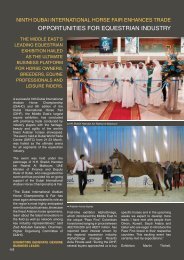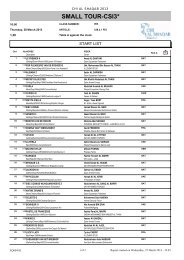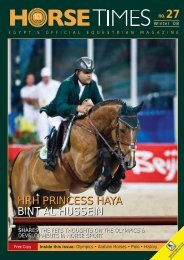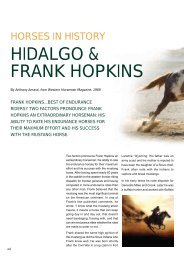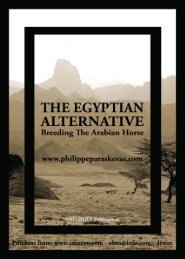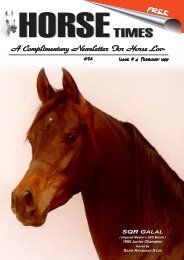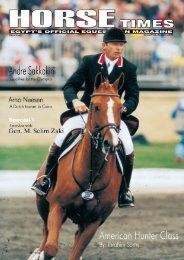HORSES OF THE DUTCH HORSES OF THE DUTCH - Horse Times
HORSES OF THE DUTCH HORSES OF THE DUTCH - Horse Times
HORSES OF THE DUTCH HORSES OF THE DUTCH - Horse Times
Create successful ePaper yourself
Turn your PDF publications into a flip-book with our unique Google optimized e-Paper software.
Jeroen Jeroen Dubbeldam Dubbeldam<br />
Dubbeldam<br />
and and De De Sjiem<br />
Sjiem<br />
<strong>Horse</strong>s <strong>Horse</strong>s <strong>Horse</strong>s <strong>Horse</strong>s <strong>Horse</strong>s Of Of Of Of Of The The The The The Dutch Dutch Dutch Dutch Dutch<br />
From rom FF<br />
Friesians F riesians to to Dutch Dutch drafts, drafts, the the Netherlands Netherlands has has produced produced produced a a very very successful<br />
successful<br />
horse horse with with world world wide wide influence influence influence within within a a short short period period period of of time.<br />
time.<br />
When people think of Holland, the familiar images that spring to mind are usually picturesque windmills, cobalt blue Delft<br />
pottery, colourful tulip fields, and the legendary Hans Brinker; but we hardly ever imagine horses. After all, this country<br />
contains only 750,000 acres with much of that being former wetlands-not exactly prime horse breeding country. However,<br />
for centuries Holland has been one of the most influential countries for producing horses. The Dutch were responsible for<br />
developing the mighty Friesian, the horse that carried knights to the Crusades. They were also the horses of choice for the<br />
King’s Household Cavalry in Britain during the reign of Charles II, and most importantly, the Friesian was the ancestor to<br />
the Shire and the Oldenburg. The Dutch also created three breeds of horses specifically to till their complicated soil-the<br />
Dutch Draft for the heavy marine clay in the provinces of Zeeland and North Brabant, the Groningen to work the salty clay<br />
soil of the north; and the Gelderlander for the sandy soil indigenous to the middle of the country. Later, in the 1950s,<br />
when tractors replaced draft horses, the resourceful Dutch used the Gelderlander and Groningen to develop a warmblood<br />
of their own to fill the world wide demand for sport horses.<br />
The The The Gelderlander<br />
Gelderlander<br />
The Gelderlander was bred in the province of Gelder and is somewhat of a variation<br />
on a theme of the Groningen. The differences between the two breeds can be found<br />
in the Gelderlander’s finer, less drafty build and flashier action.<br />
The Gelderlander’s breeding, which began over 100 years ago, is a mixed bag of<br />
genes from all over the world including Cleveland Bays, roadsters, Arabians,<br />
Hungarian horses and half-bred horses from the United Kingdom, the Orlov Trotter<br />
from Russia and of course, the Dutchman’s favourite, the German Oldenburg. Later,<br />
Friesian blood was introduced as well as Hackney, which may be responsible for its<br />
expressive movement. Today the Gelderlander is prized as a competitive driving<br />
horse, which is no surprise since coach work is what it was initially bred to do. But it is<br />
still used as a large riding horse, and a few are even seen in jumping competitions.<br />
Their conformation remains much the same today: plain but impressive, with a lofty<br />
action. However, even with its many uses, the Gelderlander remains a rare breed<br />
with only 300 mares and 10 stallions in existence. Breeders are working to keep<br />
bloodlines pure despite that the breed has been absorbed into the Dutch Warmblood<br />
studbook<br />
Famous amous Dutch Dutch<br />
Dutch<br />
Guenter Guenter Guenter Seidel Seidel Seidel and and and F FFoltaire<br />
FF<br />
oltaire<br />
The Sydney Olympics gave Dutch Warmbloods a chance to really shine. In show jumping, the breed was best represented<br />
by Jeroen Dubbeldam and his partner De Sjiem, who made their home country of Holland proud by winning the individual<br />
gold. Markus Fuchs and his horse Tinka’s Boy helped the Swiss team win the silver, and later at 2001 the couple was<br />
crowned world champions at Gotborg. American dressage rider Guenter Seidel and Foltaire helped their team win the<br />
bronze, and British dressage rider Emile Faude gave England their best score in years with Rascher Hopes.



